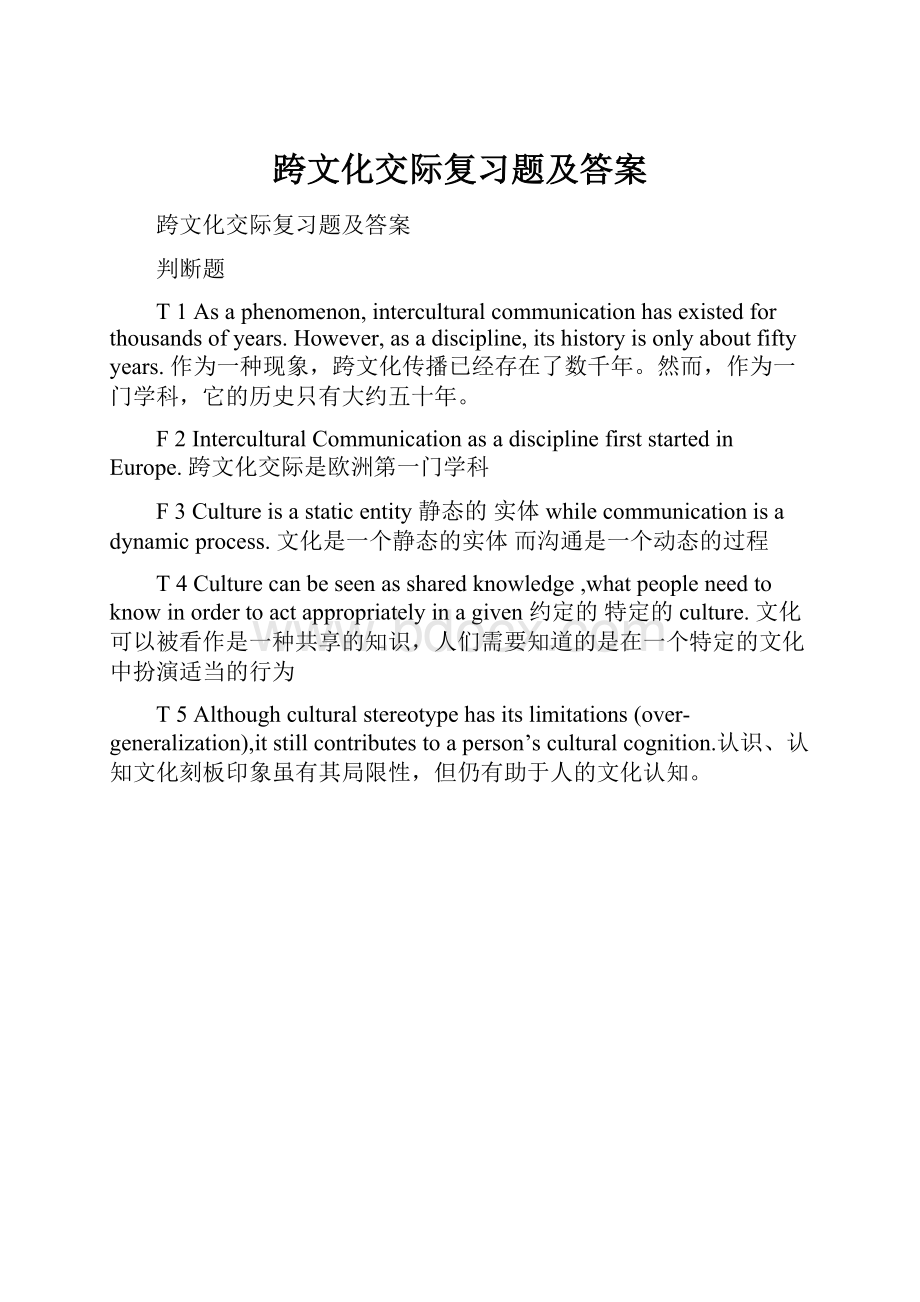跨文化交际复习题及答案.docx
《跨文化交际复习题及答案.docx》由会员分享,可在线阅读,更多相关《跨文化交际复习题及答案.docx(17页珍藏版)》请在冰豆网上搜索。

跨文化交际复习题及答案
跨文化交际复习题及答案
判断题
T1Asaphenomenon,interculturalcommunicationhasexistedforthousandsofyears.However,asadiscipline,itshistoryisonlyaboutfiftyyears.作为一种现象,跨文化传播已经存在了数千年。
然而,作为一门学科,它的历史只有大约五十年。
F2InterculturalCommunicationasadisciplinefirststartedinEurope.跨文化交际是欧洲第一门学科
F3Cultureisastaticentity静态的实体whilecommunicationisadynamicprocess.文化是一个静态的实体而沟通是一个动态的过程
T4Culturecanbeseenassharedknowledge,whatpeopleneedtoknowinordertoactappropriatelyinagiven约定的特定的culture.文化可以被看作是一种共享的知识,人们需要知道的是在一个特定的文化中扮演适当的行为
T5Althoughculturalstereotypehasitslimitations(over-generalization),itstillcontributestoaperson’sculturalcognition.认识、认知文化刻板印象虽有其局限性,但仍有助于人的文化认知。
T_2、Don’ttakeoffence-gettingtheformofaddress”wrong”israrelyintendedtobeoffensive.不要拿“错误”的形式来攻击,这是很难得的进攻
T_3、Addressingformslike“MissMary”,”Brown”bytheChinesemaybeaformofculturalcompromise.解决形式如“玛丽小姐”,“棕色”由中国可能是一种文化妥协的形式。
T_4.RanksinthearmedforceslikeCaptain,Colonelcanbeusedastitles.上校,上校,上校,可以用作头衔
F_5.WesternerscanunderstandwhatUnclepolicemanorP.L.A.Unclemeans.西方人能够理解警察叔叔和解放军叔叔的手段。
F6.WecanaddressJasonDouglas,whoisalawyer,asLawyerDouglas.我们可以解决杰森道格拉斯,他是个律师,律师道格拉斯。
F_7.Chinesehospitalitytowardthewesternersisalwaysgreatlyappreciated.中国人对西方人的热情好客是非常赞赏的。
F_8.TheChinesewayofshowingconcernisusuallyappreciatedbytheWesterners.西方人对中国人的关注往往受到西方人的赞赏。
F_9.”Thankyouforcoming!
”isatypicalexpressionusedbyWesternhostswhentheguestsjustarrived.谢谢你的到来!
“当客人刚到的时候,这是西方主人使用的一种典型的表达形式。
T_10.”I’msorrytohavewastedyourtime”or“I’msorrytohavetakenupsomuchofyourtime”areusuallyappropriateforthebusinessvisit.我很抱歉浪费了你的时间”或者“我很抱歉占用了你这么多时间”,通常都是适合商务拜访的。
IIIComprehensionCheck
T1.sometimestheChinesewayofshowingmodestymaybeconsideredasfishingforcompliments.有时,中国人表现出谦虚的方式可以被视为对赞美的赞美
T2.ThesocialfunctionsofChineseandEnglishcomplimentsareroughlythesame.汉语和英语的社会功能大致相同。
T3.Ininformalsituations,alargenumberofcomplimentsareusedtomakepeoplefeelcomfortable.在非正式场合,大量的赞美是让人感到舒服的
F4.Theculturalassumptionofcomplimentsisthesamebetweencultures.文化的假设是文化的相同的。
T5.AdjectivesandverbsareoftenusedtoconveycomplimentmessageinEnglish,whileadjectives,adverbsandverbsareoftenusedinChinese.形容词和动词常被用来传递英语中的恭维话,而形容词、副词和动词常被用在汉语里。
F6.Englishcomplimentsoftenbeginwiththeword“you”whileChinesecomplimentsoftenstartwiththeword“I”.英语的赞美常以“你”一词开头,而中国人的赞美常以“我”一词开头
F7.ChinesepeoplegivemorecomplimentsindailylifethanAmericans.在日常生活中,中国人比美国人更为赞美。
F8.Americanstendstobeself-effacingintheircomplimentsresponses.美国人往往自谦在称赞别人的反应。
F9.Complimentsonother’sbelongingsaresometimesanindirectwayofrequestinAmericanculture.对他人财物的赞美有时是美国文化中的一种间接的方式
T10.Ifaguestcomplimentssomethinginanotherperson’shome,theChinesehostorhostesswillprobablygivethatthingtotheguest.如果一个客人在别人家里赞美别人的话,中国主人或女主人很可能会把这件事告诉客人。
IVComprehensionCheck
F1Verbalcommunicationismoreimportantthannonverbalcommunication.言语交际比非语言交际更为重要
F2“Dragon”meansthesametotheWesterneras“龙”totheChinese.“龙”是指同为西方人的“龙”到中国。
F3TheChinesephrase“知识分子”hasthesamemeaningas“intellectual”.中国“知识分子”具有相同的含义是“知识
T4Aterminonelanguagemaynothaveacounterpartinanotherlanguage.在一种语言中的一个术语在另一种语言中可能没有对等词
F5Inreferringtoanimalsandbirds,theChinesepracticeisgenerally,butnotalways,touse“公”or“母”toshowwhetheracreatureismaleorfemale.ThisisthesamewiththeEnglishlanguage.在谈到动物和鸟类,中国的做法是通常,但不总是,用“公”或“母”来表明该生物是否是男性或女性。
这与英语是一样的。
T6ThefollowingsixEnglishword:
“vice”,“associate”,“assistant”,“deputy”,“lieutenant”and“under”canallmean“副”inChineselanguage.以下六个英文单词:
“副”、“联想”、“助理”、“副”、“中尉”和“下”都是“副”在汉语中
F7ThereareasmanysimilaritiesasdissimilaritiesbetweenEnglishproverbsandChineseproverbs.有许多相似之处,英语谚语和汉语谚语的异同。
T8Violatingaculturaltabooisasseriousasviolatingaverbaltaboo,违反文化禁忌的是严重违背了言语禁忌
T9Patternsofthoughtvarieswithculture.思维方式随文化而变化。
T10Particularthoughtpatternspredominateineachculture,e.g.Americancultureispredominantlyfactual-inductive,Russiancultureispredominantlyaxiomatic-deductive,andArabculturesarepredominatelyintuitive-affective.
在每一个特定的思维模式主导文化的T10,例如美国文化主要是事实的归纳,俄罗斯文化主要是公理化演绎,和阿拉伯文化以直观的情感。
VComprehensionCheck
T1Speakingisjustonemodeofcommunication.Therearemanyothers.说只是一种交流方式。
还有许多人
F2Someresearchersassertthatinface-to-facecommunication,about70%ofinformationiscommunicatedthroughspeaking,andover30%sissentbynonverbalmeans.一些研究者断言,在面对面的交流中,约有70%的信息是通过说话,而超过30%则是通过非语言方式发送的
T3Environmentisoneofthefivestudyareasthatnonverbalcommunicationcovers.环境是非语言交际的五个研究领域之一
T4Muchofournonverbalbehavior,likeculture,tendstoelusive,spontaneousandfrequentlygoesbeyondourawareness.我们大部分的非语言行为,如文化,往往难以实现,自发的,往往超越我们的认识
F5LatinAmerican,African,ArabandmostAsianculturesareM-Timecultures.拉丁美洲,非洲,阿拉伯和大多数亚洲文化是单一的文化。
T6Arabbelongstotoughcultures.阿拉伯属于艰难的文化
T7Insomecultures,eyecontactshouldbeavoidedinordertoshowrespectorobedience.在一些文化中,为了表示尊重或服从,应该避免使用目光接触
T8theappropriatenessofphysicalcontactvarieswithdifferentcultures.身体接触的适宜性因不同的文化而不同
F9WesternwomenusuallylikeChinesetotouchtheirbodiesorsmallchildren.西方妇女通常喜欢中国人接触他们的身体或小孩。
F10Seatingarrangementsreflectculture.Chinesepeopletendtotalkwiththoseoppositethemratherthanthoseseatedorstandingbesidethem.座位安排体现文化。
中国人倾向于和他们说话,而不是坐在他们旁边的人
VIComprehensionCheck
F1.Genderistheculturalmeaningof“sex”.性别是“性”的文化内涵
F2.Sexandgenderaresynonymous.同义的性别和性别是同义词
T3.Aladymightbefeminine,masculineoracombinationofboth.一位女士可能是女性,男性或两者的结合
T4.Womenaregenerallycomfortablewithbuildingcloserelationshipsandconfidingtoothers,whilemostmenarereservedaboutinvolvementanddisclosure.女性一般舒适与建筑密切关系和信任别人,而大多数人都保留对参与和披露。
F5.Mostmenusecommunicationtocreateconnectionorequalitybetweenpeople.大多数人用沟通来建立联系或平等的人
F6.Womenusuallyusecommunicationtoestablishstatusandpower.女性通常使用沟通来确立地位和权力
T7.Infeminineculture,communicationisaway—probablytheprimaryway—toexpressandexpandcloseness.在女性文化中,传播是表达和扩大亲密关系的主要途径。
T8.Masculinesocializationstressesdoingthingsandregardsactionasprimarywaystocreateandexpresscloseness.男性社会化强调做事情,把行动视为创造和表达亲密的主要方式。
T9.Thefirstandlastprincipalforeffectivecross-gendercommunicationissuspendingjudgment.有效的跨性别传播的第一个和最后一个主要是中止判断。
T10.Itisdifficultbutpossibletoseektranslationcuesthatwillfacilitateourcommunication.这是困难的,但可能寻求翻译线索,将有利于我们的沟通。
T1.Themostcommonproblemsincross-culturalnegotiationsconcern
(1)rulesforconductingbusiness,
(2)theselectionofnegotiators,and(3)methodsofdecision-making.最常见的问题,在跨文化谈判的关注
(1)的规则,进行业务,
(2)的选择,谈判,和(3)决策方法。
T2.TheJapanesebelievethatsocializingisintegraltothenegotiationprocesswhiletheAmericansdonotthinkso.日本人认为,社交是谈判过程中不可或缺的一部分,而美国人却不这么认为
F3.Americannegotiationteammembersareusuallyselectedonthebasisoftheirsocialandprofessionalstatus.美国谈判团队成员通常在他们的社会和职业地位的基础上
F4.LikeJapaneseandChinesenegotiators,adetailedwrittenagreementisnotcentraltothenegotiationprocessintheMiddleEast,MexicoandFrance.与日本和中国的谈判人员一样,在中东、墨西哥和法国的谈判进程中,有一个详细的书面协议是不一样的。
T5.TheBritishemployanegotiatingstylesimilartothatofAmericans,butmoresilenceisutilizedandtheyarelessegalitarian.英国人采用了类似于美国人的谈判风格,但更多的是利用沉默,他们也不太平等。
T6.Germanspreferclear,firm,andassertireexpressionwhiletheJapaneseencourageconvert,fragmentedexpression.德国人喜欢明确的,坚定的,和assertire表达而日本鼓励转换、碎片化的表达
T7.Mexicannegotiatorspreferthedeductiveapproach.Moreemphasisisplacedoncontemplationandintuition.墨西哥谈判者更喜欢演绎的方法。
更强调的是沉思和直觉。
F8.TheBraziliansdonotopenlydisagreeduringformalnegotiations;theywouldconsiderthisinsultingandembarrassing.在正式谈判中,巴西人不会公开地不同意,他们会考虑这种侮辱和尴尬。
T9.CreatingacomfortableclimateandspendingtimeontheexploratoryphaseofnegotiationsarecrucialinMiddleEastandBrazil.创造一个舒适的气候和花费时间在谈判的探索阶段是至关重要的中东和巴西。
F10.WomenarefrequentparticipantsonaJapanesenegotiationteam.女性经常参加一个日本谈判小组。
名词解释
1economicglobalization(经济全球化):
theintegrationofnationaleconomiesintotheinternationaleconomythroughtrade,foreigndirectinvestment,capitalflows,migration,andthespreadoftechnology.
2bartersystem(物物交换):
exchangewithoutmoney
–Farmingcommunitiestradedtheirsurplusproduceinexchangeforproductsandserviceswithoutthemediumofmoney.
–Humansocietyhasalwaystradedgoodsacrossgreatdistances.
3globalvillage(地球村):
theworldformonecommunity
–Allthedifferentpartsoftheworldformonecommunitylinkedtogetherbyelectroniccommunications,especiallytheInternet.
4meltingpot(大熔炉):
asocio-culturalassimilationofpeopleofdifferentbackgroundsandnationalities.
5culture(文化):
canbeenseenassharedknowledge,whatpeopleneedtoknowinordertoactappropriatelyinagivenculture.
6culturaldiversity(文化融合):
referstothemixofpeoplefromvariousbackgroundsinthelaborforcewithafullmixofculturesandsub-culturestowhichmembersbelong.
7.Communication(交际):
meantosharewithortomakecommon,asingivingtoanotherapartorshareofyourthoughts,hopes,andknowledge.
8interculturalcommunication(跨文化交际):
communicationbetweenpeoplewhoseculturalbackgroundsanddistinct(不同)enoughtoalter(改变)theircommunicaion。
1Pragmatics(语用学):
thestudyoftheeffectthatlanguagehasonhumanperceptionsandbehavior.
2Semantics(语义学):
asystemthatassociateswordstomeaning.Itisthestudyofthemeaningofwords.
3Denotation(引申含义):
theliteralmean